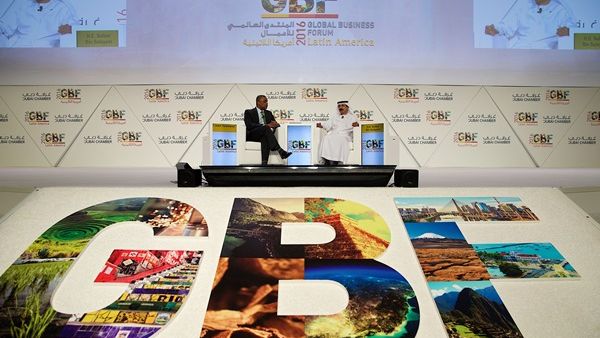Dubai Chamber Commissions Economist report on Latin America ahead of Global Business Forum 2016

The Dubai Chamber of Commerce and Industry commissioned The Economist’s Intelligence Unit (EIU) to conduct an economic study on the Latin American region ahead of the Global Business Forum on Latin America, taking place on November 9-10, 2016, at Atlantis, The Palm, Dubai.
Titled “Latin America: Room for Growth”, the new study explores the economic situation – as well as the socio-political conditions – in the Latin American region, looking into the key strategic sectors that present the most potential for growth, and taking into account the strategies implemented by governments around the region to overcome the political and economic instabilities plaguing Latin America.
His Excellency Hamad Buamim, President and CEO of Dubai Chamber, said: “The Dubai Chamber of Commerce and Industry is committed to providing its member companies with top-quality services. This study, which the Chamber has commissioned in the run-up to the Global Business Forum on Latin America, reflects our dedication to keep up with the latest global economic developments, in order to provide investors with the most accurate, up-to-date information so they can make informed investment decisions that stand to shape the economic future of the country, the region, and even the world.”
“We are closely monitoring the economic developments taking place in Latin America, and, considering the robust plans set by the region’s governments and the general direction of the local markets, we project further growth for the region, and strive to play a key role in affecting positive change there,” H.E. Buamim explained, adding: “We are working to flag the sectors that are most in need of investments, drawing a clear map of the gaps and shortcomings that GCC investors and governments can capitalise on – in collaboration with the relevant Latin American authorities – to generate additional profits for both regions.”
Economic Realities of Latin America
The study highlights the major threats faced by the region, as the Brazilian economy experienced a contraction of 3.8% in 2015 and is forecast it to contract another 3% in 2016. Weak prices for oil and other commodities have hit large commodity exporters hard, with lower export revenues hampering growth in Venezuela, Colombia, Ecuador, Chile and Argentina. Even the Mexican economy, which is more closely tied to the economic fortunes of the US, is seeing slower growth.
Inflation has also edged up in many countries, reflecting local-currency depreciation (which raises import costs and therefore usually raises local prices). Meanwhile, a strong El Niño disrupted much of the region's agricultural sector. Argentina, Chile, Paraguay and Uruguay were hit by severe flooding, while others, such as Central America, Colombia and Venezuela, were affected by drought.
Private consumption was weak, a reflection of persistent high unemployment in many countries, slowing credit growth, moderate wage increases and low levels of consumer confidence. Weak government consumption is a reflection of the continued fiscal reliance on commodity prices to finance government spending and public investment. The external balance (the value of exports minus imports) was the strongest component of overall growth, reinforcing the extent to which Latin America is reliant on exports to underpin GDP growth. By contrast, fixed investment represented a significant drag on growth.
Room for Growth and Investment Opportunities
The study explores measures implemented by the governments of the region to restructure their economies and increase their competitiveness. The report points to two key strategies. The first is infrastructure development to improve internal transport links and facilitate trade, capitalising on the importance of exports as a component of GDP growth.
The second strategy, meanwhile, deals with encouraging private consumption by expanding the offerings of the services sector, as raising government consumption will prove challenging in this fiscal climate.
Reforms overs the past two decades have reduced fiscal vulnerabilities, cut inflation and engendered greater macroeconomic stability in Latin America. Domestic conditions have stabilised, with a lower incidence of boom-bust cycles and debt defaults than previous decades. This helped the region build up a cushion of foreign-exchange reserves, amounting to US$818 billion in 2015. Elsewhere, Brexit may lead to stronger trade ties between Britain and Latin America as the former attempts to replace markets potentially lost in the European Union following its exit.
Infrastructure
Across Latin America, efforts to facilitate trade through infrastructure development have begun. Most governments are focusing on upgrading port infrastructure in order to remove logistical bottlenecks, arising from relatively shallow ports and inadequate equipment and facilities to accommodate large “post-Panamax” super tankers.
In mid-September, the Brazilian president, Michel Temer, launched a plan for the completion of 34 infrastructure projects by 2017-18, including the construction of four regional airports, roads, railways and power plants, with public investment amounting to R$30bn (US$9.1bn). In Colombia, the administration of Juan Manuel Santos is moving ahead with 'Plan 4G'—a Ps50trn (US$17bn) road concession programme focused on the links between the main cities and the country's Pacific and Atlantic ports. The goal is to facilitate foreign trade by reducing transport times. This forms part of a wider 2015-30 'Master Plan' that envisages annual investment of US$10.4bn aimed at boosting exports. The plan includes over 12,500kms of road projects, over 1,600kms of new railway, river transport projects, as well as airport expansions and port development.
In Peru, several major projects are already under way, including the construction of a second line of the Lima metro, while others (including a third and fourth metro line, a rail network linking Lima and nearby cities, and a second runway at Lima's international airport) are likely to progress in the near-term. In Mexico, budget cuts have scaled-back the government’s original infrastructure spending plans—from 6% to 4% of GDP—but there are still a significant number of large infrastructure projects progressing, including work towards upgrading the quality of ports and airports.
Chile stands apart in the region for its robust infrastructure, notes Paul Wander a Chile-specialist economist, which in large part reflects a successful concession system that was launched in the early 1990s. Further development is likely: Despite cutbacks in public spending in 2016-17, funding on new transport infrastructure is continuing. New underground railway lines are being built in the capital, Santiago, and a new deep-water port in central Chile is in the pipeline. Three regional airports are likely to be upgraded and a new terminal at Santiago airport is also in the works.
Public-Private Partnerships (PPPs)
On a different note, Peru has an ambitious public-private partnerships (PPP) programme in the pipeline and the Argentinian Congress is in the midst of debating a much-needed PPP law, which will provide greater security to prospective investors. For infrastructure projects in Brazil, some of the regulations governing concessions have been changed in order to increase their attractiveness to foreign investors. Not only will more public money be available, but investors will be given more time to conduct feasibility studies, regulatory agencies will take more of a back-seat role and previous difficulties in securing environmental licenses should be ironed out.
There are other initiatives to encourage private-sector investments. In Peru the "public works for taxes" scheme allows private companies to invest part of their tax payments in infrastructure. Originally designed for transport infrastructure, it has been expanded to cover schools, clinics, and water and sanitation infrastructure. In Colombia, a new investment fund unveiled earlier in 2016 will facilitate joint ventures with the private sector and also act as a guarantor, enabling private investors to access cheaper and longer-term financing.
Services
Just as development of infrastructure could provide a significant boost to growth rates in the region, many governments are also looking at developing their services sectors as part of their economic growth strategy. Efforts to expand the services sector across Latin America essentially fall into two separate categories: capitalising on a country's geographic location (Mexico, Central America and the Caribbean, for example, are boosting efforts to benefit from their proximity to the US market, as well as, in most cases, cheaper labour costs), and responding to the expanding middle class in large parts of the region.
Since the North American Free Trade Agreement (NAFTA) was signed in the mid-1990s, Mexico's export-oriented manufacturing has thrived, with many US and foreign companies relocating production to Mexico. As a result, Mexico has gradually moved up the value chain within the manufacturing segment, evidenced in a nascent aerospace industry. The government developed supporting services, including in this case a large network of technological institutions and research centres clustered around production centres.
Panama and Costa Rica are other examples of countries where exports have gradually shifted to either higher tech-based goods or more knowledge-intensive services, designed specifically with the proximity of the US market in mind. In Panama, these are mainly financial services and in Costa Rica, these include IT outsourcing and business services.
Throughout the Central America and Caribbean sub-region, there is a greater push to develop port services, in an attempt to capitalise on the increased amount of shipping traffic following the expansion of the Panama Canal. The expansion facilitates Asian exports to the US, particularly the east coast. Many governments are investigating ways of capitalising on this, looking at the construction of re-assembly facilities and industrial parks in conjunction with port upgrades.
Tourism
Tourism is another sector that many governments are seeking to develop. Tourism is already saturated in much of the Caribbean (it accounts for 41% of total exports in the Caribbean) and developed (if not saturated) in a few other countries including Mexico and Costa Rica. Recent local-currency depreciation makes many of them comparatively cheap holiday destinations, with the exception of “dollarised” economies such as Panama and Ecuador. Given that the tourism sector is often a large employer, contributing an estimated 8.3% of total employment in Latin America in 2014[1], there is greater incentive for governments to support growth of the sector. Concurrent improvements in road infrastructure will facilitate tourist travel as well as merchandise trade.
Banking and Finance
Meanwhile, the growth of the middle class in Latin America opens up a variety of investment opportunities for firms looking to develop domestic services associated with rising income levels. An expanding middle class is emerging in almost every Latin American country, with the exception of Venezuela. Although high levels of financial “dollarisation” undermined stability in many countries (many people tend to save in US dollars as confidence in the local banking sector and currency is low, exposing it to currency volatility), in recent years, structural reforms to strengthen regulation, develop local capital markets, welcome foreign banks and improve risk management practices have boosted the sector.
Greater underlying macroeconomic stability compared with previous decades has also led to more stable credit growth. As income levels rise in Latin America, there is likely to be continued credit growth, not just in consumer lending, but also for mortgage finance—traditionally accounting for a very small share of banks' loan portfolios. Mortgage finance in Latin America's main economies accounts for 7% of GDP, a fraction of levels in emerging Asia and the US.
The Global Business Forum on Latin America is set to explore these promising sectors and statistics at length, as they constitute a real opportunity for Gulf Cooperation Council (GCC) countries to bolster their relations – chiefly, economic ties – with their Latin American counterparts. This, in turn, is poised to multiply the number of transactions between the two regions, as well as to drive further GCC investments in Latin America and, subsequently, improve the region’s economies. The Forum is a platform where the most prominent companies, entrepreneurs, and decision makers from both regions can meet to explore new avenues for cooperation and new agreements and deals to sign.
Background Information
Dubai Chamber of Commerce and Industry
We are a non-profit public organization whose mission is to represent, support and protect the interests of the business community in Dubai. It does so by creating a favourable environment; promoting Dubai as an international business hub and by supporting the development of business.






